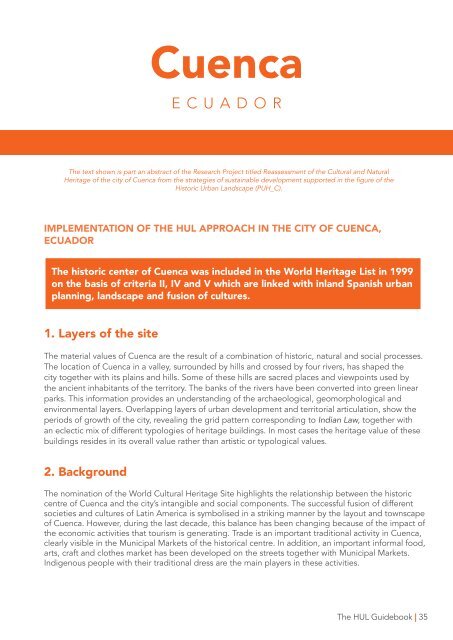GUIDEBOOK
wirey5prpznidqx
wirey5prpznidqx
Create successful ePaper yourself
Turn your PDF publications into a flip-book with our unique Google optimized e-Paper software.
Cuenca<br />
ECUADOR<br />
The text shown is part an abstract of the Research Project titled Reassessment of the Cultural and Natural<br />
Heritage of the city of Cuenca from the strategies of sustainable development supported in the figure of the<br />
Historic Urban Landscape (PUH_C).<br />
IMPLEMENTATION OF THE HUL APPROACH IN THE CITY OF CUENCA,<br />
ECUADOR<br />
The historic center of Cuenca was included in the World Heritage List in 1999<br />
on the basis of criteria II, IV and V which are linked with inland Spanish urban<br />
planning, landscape and fusion of cultures.<br />
1. Layers of the site<br />
The material values of Cuenca are the result of a combination of historic, natural and social processes.<br />
The location of Cuenca in a valley, surrounded by hills and crossed by four rivers, has shaped the<br />
city together with its plains and hills. Some of these hills are sacred places and viewpoints used by<br />
the ancient inhabitants of the territory. The banks of the rivers have been converted into green linear<br />
parks. This information provides an understanding of the archaeological, geomorphological and<br />
environmental layers. Overlapping layers of urban development and territorial articulation, show the<br />
periods of growth of the city, revealing the grid pattern corresponding to Indian Law, together with<br />
an eclectic mix of different typologies of heritage buildings. In most cases the heritage value of these<br />
buildings resides in its overall value rather than artistic or typological values.<br />
2. Background<br />
The nomination of the World Cultural Heritage Site highlights the relationship between the historic<br />
centre of Cuenca and the city’s intangible and social components. The successful fusion of different<br />
societies and cultures of Latin America is symbolised in a striking manner by the layout and townscape<br />
of Cuenca. However, during the last decade, this balance has been changing because of the impact of<br />
the economic activities that tourism is generating. Trade is an important traditional activity in Cuenca,<br />
clearly visible in the Municipal Markets of the historical centre. In addition, an important informal food,<br />
arts, craft and clothes market has been developed on the streets together with Municipal Markets.<br />
Indigenous people with their traditional dress are the main players in these activities.<br />
The HUL Guidebook | 35


